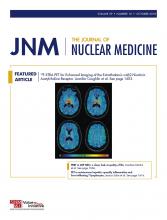TO THE EDITOR: We read with great interest the paper by Savio et al. (1) on the imaging of resting-state networks (RSNs) from simultaneous 18F-FDG PET/functional MRI (fMRI) data. The authors applied an independent component analysis (ICA) commonly used in fMRI and reported fair cross-modality agreement for several RSNs. In view of the distinct nature of the neurovascular and neurometabolic couplings, this tends to confirm the neural basis of RSNs, in line with recent magnetoencephalographic studies. Interestingly, some networks were only identified in one modality or the other, for example, the 18F-FDG PET ICA reported by Savio et al. (1) failed at detecting the salience/insular or temporopolar RSNs disclosed in the corresponding fMRI ICA. This leaves the question of their neural underpinning pending.
Methodologically, this study focused on the ICA technique. A complementary approach is seed-based functional connectivity (sbFC) whereby a seed location is selected a priori as part of the sought network, and correlation maps are estimated between the seed and all other voxel activities. Compared with ICA, sbFC is straightforward to interpret and avoids the issues of selecting the number of components (which affects ICA decompositions) and visually discriminating between physiologic and noise components. Furthermore, sbFC can be subjected to the rigorous statistical framework of random field theory (RFT) (2), henceforth eliminating the usage of somewhat arbitrary thresholds. Supplementing ICA with sbFC thus appears necessary for robust inferences about RSNs.
We hereby report that sbFC analysis of 18F-FDG PET data do allow statistical mapping of most RSNs, including those unidentified from the 18F-FDG PET ICA (1).
Specifically, we considered a resting-state (eyes closed) 18F-FDG PET dataset of 50 healthy adults (27 women; age range, 18–43 y) whose acquisition and preprocessing procedures have been detailed in a previous publication (3). We used SPM8 (http://www.fil.ion.ucl.ac.uk/spm/, Wellcome Trust Centre for Neuroimaging) to design voxelwise general linear models of the 18F-FDG PET images with metabolism at the seed location as covariate of interest. One-sided t tests were then applied to identify significantly positive sbFC, both at P < 0.05 with the whole-brain familywise error rate controlled by RFT and at P < 0.001 uncorrected.
Figure 1 illustrates the statistically masked sbFC t-maps obtained from selected seeds. Several RSNs emerged at RFT significance, from low-level (e.g., sensorimotor, visual) to cognitive (e.g., language, executive) and subcortical (e.g., cerebellar, basal ganglia) networks. Other RSNs were identified only partially but recovered at P < 0.001 uncorrected (e.g., auditory, default-mode, and frontoparietal networks). In line with the discussion in Savio et al. (1), this may be due to the nondynamic nature of our 18F-FDG PET data. Indeed, compared with fMRI, the loss of temporal samples strongly limits the sensitivity of correlation estimates. Importantly, the salience/insular and temporopolar RSNs missing in the 18F-FDG PET ICA (1) were identified as well. The reason may simply be that our dataset contains approximately 2.3 times more subjects, leading to approximately 33% less correlation noise. Indeed, repeating our sbFC analyses on half our population failed at revealing these 2 RSNs. Besides, this increase in sampling size would enable computing extra 18F-FDG PET ICA components possibly disclosing these RSNs.
Statistically masked sbFC t-maps obtained from selected seeds.
Together with previous seminal studies that had some shortcomings limiting the interpretations of their results (4,5), Savio et al.’s study (1) and our 18F-FDG PET data obtained by statistical sbFC mapping bring novel evidence that the field of RSNs—up to now exclusive to fMRI and to a lesser extent extracranial electrophysiology—can be expanded to the realm of neurometabolism and thus pervades all functional neuroimaging. In particular, the combination of sbFC with ICA applied to resting-state 18F-FDG PET data opens novel scientific and clinical lines of research on the neurometabolic processes associated with functional integration and its pathologic disruptions by brain disorders.
Footnotes
Published online Apr. 26, 2018.
- © 2018 by the Society of Nuclear Medicine and Molecular Imaging.
REFERENCES
- Received for publication April 12, 2018.
- Accepted for publication April 17, 2018.








